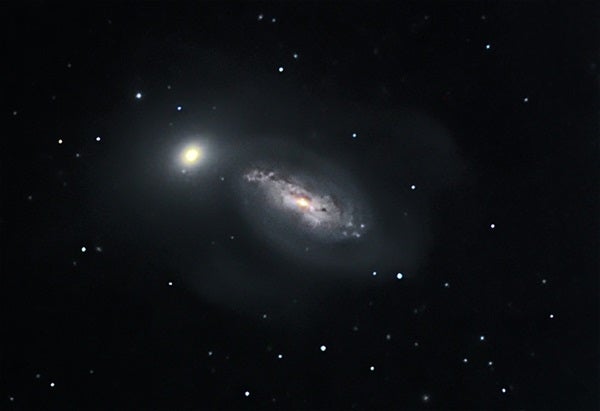Targets for April 7–14, 2016
6-inch or larger telescope: Spiral galaxies NGC 3227, NGC 3338, NGC 3489, and NGC 3507 in the constellation Leo the Lion
Two for the price of one
This week’s first target is NGC 3227. It shines at magnitude 10.3 and measures 6.9′ by 5.4′.
You’ll find this object and its companion, the magnitude 11.4 elliptical galaxy NGC 3226, 50′ east of magnitude 2.0 Algieba (Gamma [γ] Leonis). The elliptical appears to be attached to the northern end of the brighter galaxy.
Through 6-inch and larger telescopes, NGC 3227 appears oval-shaped with a long, concentrated central region. Its outer halo has an abrupt edge. NGC 3226 appears circular with a broad central region punctuated by a tiny, dim core.
When you’re #2, you try harder
This week’s second object is NGC 3338. It lies 7.9° west-southwest of magnitude 3.3 Chertan (Theta [θ] Leonis), or 1.1° west-southwest of the magnitude 5.5 star 52 Leonis.
A small telescope shows only an evenly illuminated oval roughly 50 percent longer than it is wide stretching east to west. This object glows at magnitude 11.1 and covers an area 5.7′ by 3.4′.
Through at least a 12-inch scope, however, you’ll see several zones of differing brightnesses: the faint outer halo; then the slightly brighter central region (or inner halo); and finally the stellar nucleus. The magnitude 9.0 star SAO 99253 lies not quite 3′ west of NGC 3338.
Fairly easy to spot
Number three on this week’s list is NGC 3489. At magnitude 10.3, it ties NGC 3227 for the brightest spiral on our list. It measures 3.2′ by 2.0′.
To find it, point your telescope 3.7° west-southwest of Chertan. It lies in the same direction as NGC 3338, although it’s a bit south of the line between the star and NGC 3338.
Through a 6-inch telescope, this galaxy appears as a fat oval 50 percent longer than it is wide. It orients east-northeast to west-southwest. It appears evenly illuminated without outer structure.
The challenge object
This week’s fourth and final object is NGC 3507. It glows softly at magnitude 11.8 and measures 3.3′ by 2.9′.
This galaxy lies 3.5° southwest of magnitude 2.6 Zosma (Delta [δ] Leonis). Not only is it the faintest spiral on our list, but it is tough to see details in NGC 3507 because of the magnitude 10.5 star only 30″ northeast of its core. The best bet through a large scope is to crank up the magnification past 300x to separate the star from the central region as much as possible. A slightly brighter star, magnitude 10.1 GSC 1433:1318, sits 3′ to the south.
Through an 8-inch telescope at 200x, the core appears doubled because of the superimposed star. The outer halo appears faint. Use a 16-inch scope and you’ll see the dark lanes that divide the spiral arms curving through the halo.
Expand your observing at Astronomy.com
The Sky this Week
Get a daily digest of celestial events coming soon to a sky near you.
Observing Basics
Find more guidance from Senior Editor Michael E. Bakich with his Observing Basics video series.










